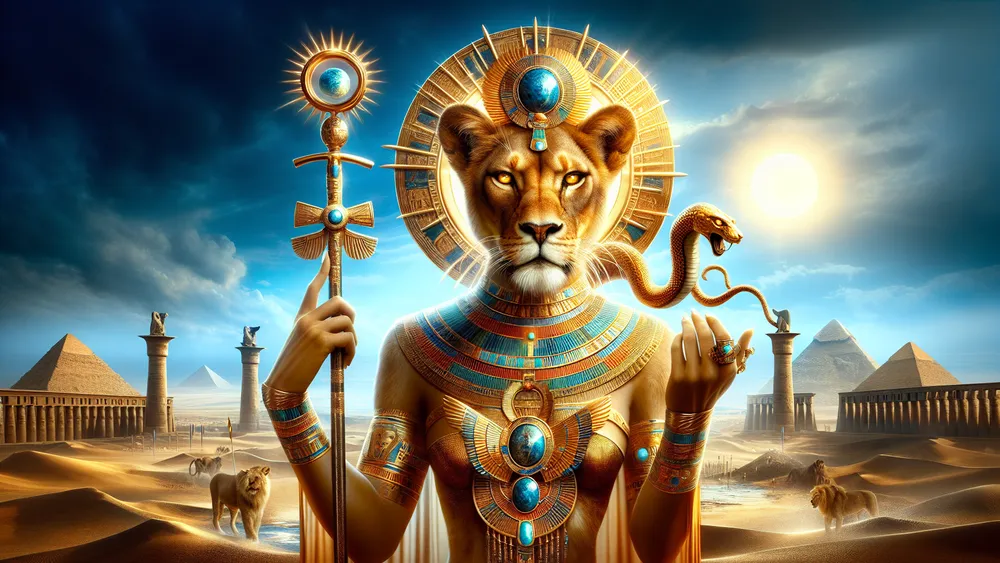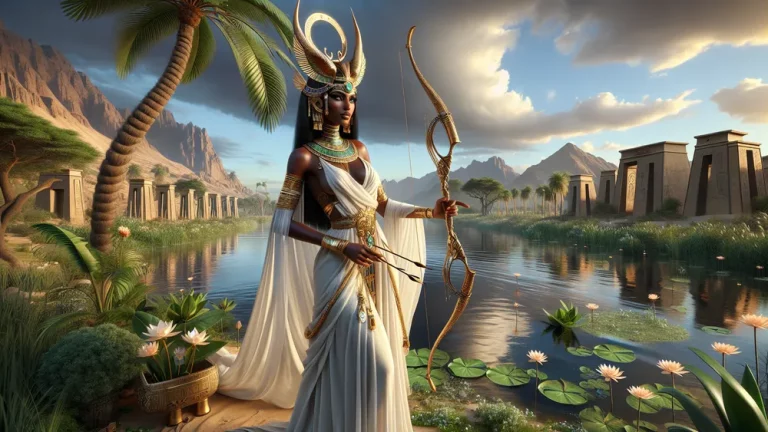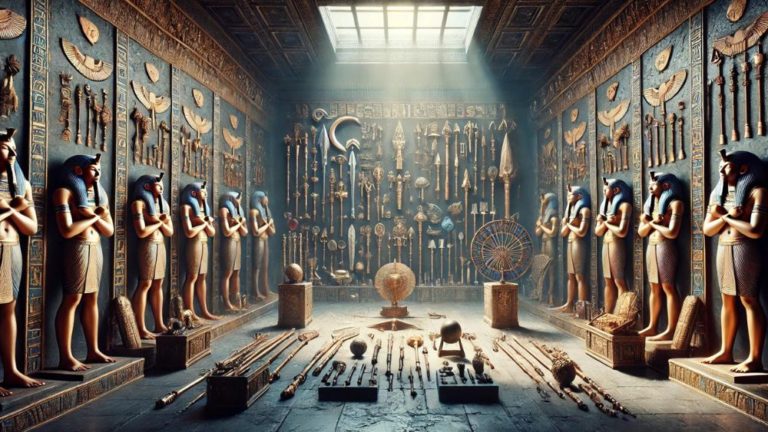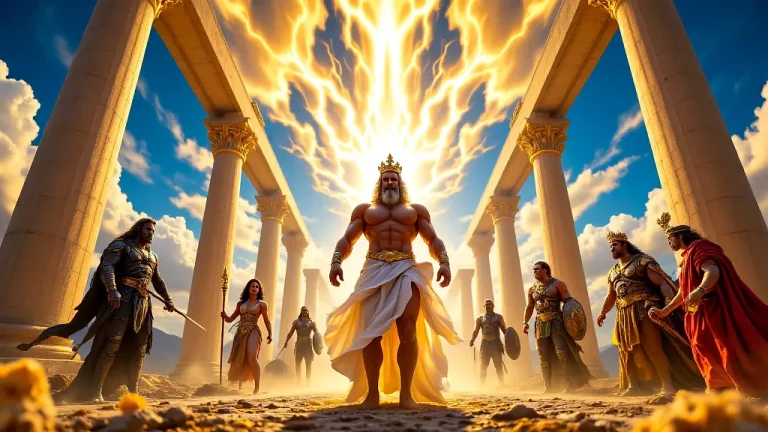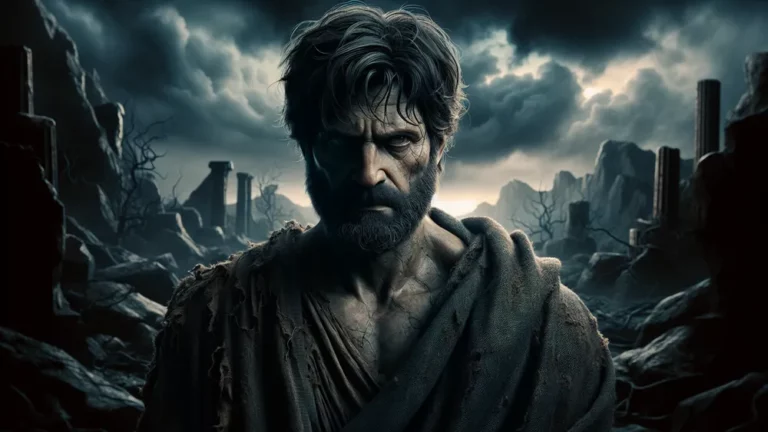Menhit: Egyptian Lioness Goddess Of Warfare
Welcome to the amazing place of ancient Egyptian mythology. Here, gods and goddesses were really important in the lives of people. In this blog post, we talk about Menhit, the lioness goddess of war. Think yourself in very old Egypt, a land where the divine and human worlds mix together easily. Menhit, a strong and protective goddess, was vital for her power and skills in fighting.
Key Points:
- Menhit is the Egyptian lioness goddess of warfare.
- Her name means She Who Kills Many or She Who Destroys Many.
- Menhit is often shown as a lioness or a woman with a lioness head.
- She is linked with other lioness deities like Sekhmet and Bastet.
- Menhit was worshipped mainly during the New Kingdom period.
- She is called upon for protection in battles and times of conflict.
- Menhit’s modern representation is seen in stories, movies, and art, symbolizing strength and protection.
While reading this post, you will find out who Menhit is. And her origins. And what her name means. We will look into old writings and carvings that say things about her and see her symbols and how she is indicated in art.
You also find out about her connections with other lioness deities, her family, and how people worshipped her. In the end, we will see how Menhit is now pointed out in today’s media and art and her place with other Egyptian gods. Thus, let’s start ‘this journey‘ to find out about Menhit, the lioness goddess of war.
Menhit: Overview and Key Facts
| Key Point | Description |
|---|---|
| Name | Menhit (sometimes written as Menchit or Menhet) |
| Meaning of Name | “She Who Kills Many” or “She Who Destroys Many“ |
| Role in Mythology | Goddess of war, guarding, and killing in large numbers |
| Depiction | Usually pointed out as a lioness or a woman with a lioness head |
| Symbols | Lioness, weapons like spears and arrows |
| Consort | Khnum, the god with a ram head of the Nile and creation |
| Offspring | Heka, the magic and medicine god |
| Worship Centers | Temples mostly in Upper Egypt, especially in Esna and Latopolis |
| Historical Period | Worshiped mainly during the New Kingdom times (around 1550–1070 BCE) |
| Connection with Other Deities | Linked with other lioness goddesses such as Sekhmet and Bastet |
| Rituals and Prayers | Called upon for protection in fights and during times of conflict |
| Modern Representation | Seen in modern stories, movies, and art representing strength and protection |
Who is Menhit?
Though it might not be simple, we need to go into where Menhit comes from, what her name means, and the big part she plays in ancient Egyptian myths.
Her Background and What Her Name Means
Menhit’s name, coming from the old Egyptian language, means “She Who Slaughters” or “She Who Massacres,” which points out her strong nature as a goddess of war. Picture the old Egyptians saying Menhit’s name before going to fight, wanting her help and strength. In history, Menhit was mostly worshipped during the New Kingdom time, around 1550–1070 BCE. Her worship was especially strong in Upper Egypt.
As a goddess, she had a big role in Egyptian myths, indicating the protective and destroying sides of war.
To understand her importance, think about these main points:
- Menhit often appeared as a lioness, pointing out her fierceness and power.
- She was linked with other lioness goddesses like Sekhmet and Bastet, who also show parts of war and protection.
- Her followers did rituals and said prayers to win and stay safe in battles.
Menhit, a goddess of war in ancient Egypt, was worshipped during the New Kingdom era and symbolized by a lioness, emphasizing her power and role in battle.
Menhit in Ancient Writings and Carvings
Menhit appears a lot in old Egyptian texts and carvings, which give useful looks into her role and features. For example, she is seen in the Pyramid Texts, a group of old religious writings from the Old Kingdom, where she is called upon for help and strength.
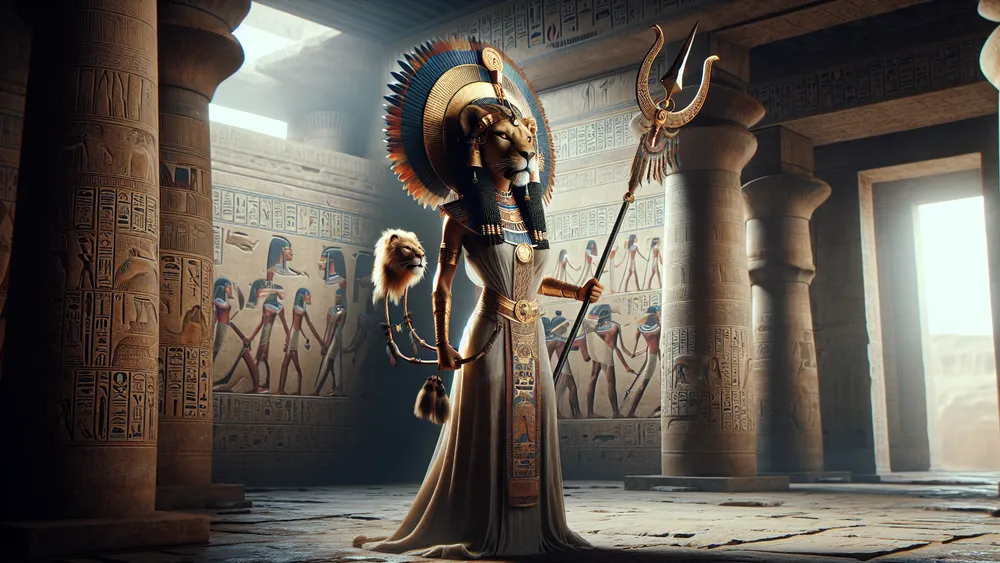
Also, temple carvings, like ones in the Temple of Esna, often indicate Menhit with other gods, presenting her importance in the group of gods. These writings not only confirm her role as a goddess of war but also stress her protective nature, often asking her to protect the pharaoh and his soldiers.
Important archaeological finds have also shed light on Menhit’s worship. Digs at places like Esna and Latopolis have found statues and carvings of Menhit as a lioness or a woman with a lioness head, often with weapons. These items are key to understanding how the old Egyptians saw and honored her. For example, a statue found at Esna shows Menhit in a ready-to-fight stance, which indicates her warlike features. These findings, along with textual mentions, give a clear picture of Menhit’s role in old Egyptian life. To sum up, these sources reveal:
- Menhit’s look as a fierce lioness or lioness-headed woman.
- Her link with protection and war.
- The importance of her worship in temples and other holy places.
What Menhit Represents and Her Symbols
To fully know what Menhit means, it’s vital to see how she is indicated and the symbols that go with her.
How She’s Shown and Represented
In old Egyptian art, Menhit often appears as a lioness or a woman with a lioness head, presenting her fierce nature. Think of seeing an old carving where Menhit stands ready for battle, often wearing a headdress and holding weapons like spears or knives, which indicate her role as a war goddess. These pictures are not just artistic choices but are very symbolic, indicating her traits and powers. For example, the lioness is a strong symbol of power and fierceness, and the weapons she holds stress her skill in battle.
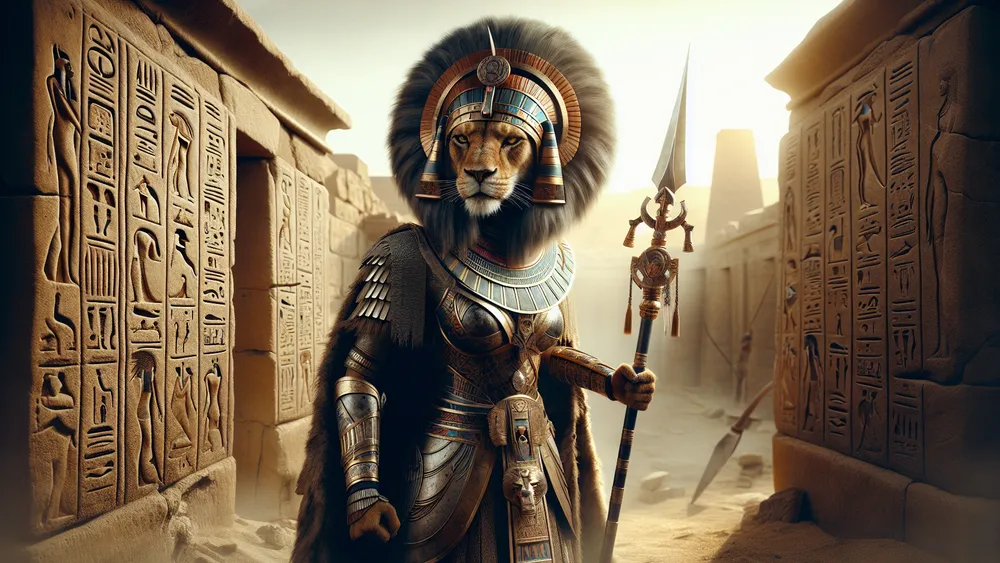
To sum up her representation:
- Menhit is usually presented as a lioness or lioness-headed woman.
- She often holds weapons, highlighting her warrior side.
- Her stance and clothes in art show her protective and fighting roles.
Menhit as a War and Protection Goddess
Menhit’s link with war goes deep into how she is pointed out as a fierce lioness, a strong symbol of power. In old Egyptian stories, she was called on before fights to give protection and make sure of winning. Picture the old fighters calling on Menhit, sure that her being there would keep them safe and bring them to win.
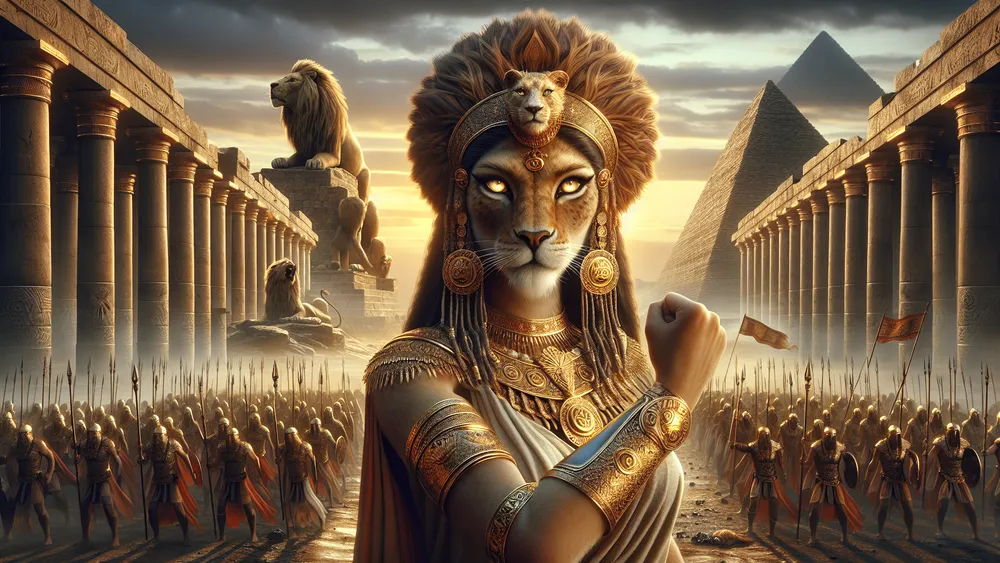
Her job as a protector is stressed in many texts and carvings, where she is called a guard of the pharaoh and his soldiers. This side of her being a protector made her big in army rituals and events with gifts and prayers for her favor.
Rituals for Menhit were fussy and aimed at getting her blessings for safety and winning in fights. These rituals had gifts of food, drink, and precious things, with prayers and songs praising her power. Priests and priestesses did these events, calling on Menhit’s name and asking for her help and safety. To know better Menhit’s special traits, it helps to look at her next to other war gods in Egyptian stories. This table indicates some key differences and similarities:
| Deity | Traits | Symbols | Job in War |
|---|---|---|---|
| Menhit | Fierce, Protective | Lioness, Weapons | Protector of fighters, ensures winning |
| Sekhmet | Destructive, Healing | Lioness, Sun Disk | Brings plague, heals after fights |
| Neith | Creator, Fighter | Shield, Arrows | Goddess of war and hunting |
This comparison indicates Menhit’s special role as a war and protector goddess, unique yet fitting with other gods in the Egyptian god group.
Menhit’s Family and Connections
To know more about where Menhit fits in Egyptian mythology, it is key to look at her links with other gods and her family ties.
Menhit and Other Lioness Goddesses
Menhit has a significant link with other lioness goddesses in Egyptian stories, such as Sekhmet and Bastet. These gods all show the fierce and protective side of the lioness, but each one has a distinct job. Menhit, Sekhmet, and Bastet can be seen as different kinds of guardians. Menhit is mainly a war goddess, called on for safety and wins in battles.
Sekhmet, also a war goddess, is known for her strong and healing powers, often called to bring plagues or cure illnesses. Bastet, however, points out a more home-loving and caring side, linked to home safety and fertility. Despite their differences, they have common signs like the lioness and are often shown with similar art. To sum up their roles and attributes:
- Menhit: War goddess, protector in battles, pointed out with weapons.
- Sekhmet: War and healing goddess, brings plagues, presented with a sun disk.
- Bastet: Home and fertility goddess, guardian of homes, presented with a sistrum (music tool).
Menhit’s Partner and Children
Menhit’s link with her partner, Khnum, is a critical part of her story. Khnum, the god of making and water, is usually shown as a ram-headed god who shapes people on a potter’s wheel. Picture Menhit and Khnum as a divine pair, where Menhit’s fierce guarding fits with Khnum’s creating and caring parts.
They are thought to have children, like Heka, the god of magic and medicine. These links are key to understanding Menhit’s spot in the Egyptian god group. They present how divine jobs are connected and the balance of making and guarding. To sum up their family ties:
- Khnum: Partner, god of making and water, presented with a ram’s head.
- Heka: Child, god of magic and medicine, signifying the mix of guarding and healing.
Menhit’s connection with Khnum and their divine partnership demonstrates the balance between guarding and creating in Egyptian mythology.
How Menhit Was Worshipped and Her Followers
Knowing Menhit’s godly connections gives a base to see how people worshipped her and what they did as followers.
Temples and Places She Was Honored
Menhit had temples and places where people respected her throughout old Egypt. One main temple for her was in Esna, with her partner Khnum. These temples often had big entrances with lioness statues pointing out her fierce side. Imagine a temple for Menhit, with tall pillars and detailed carvings of war and protection scenes. The design of these temples was not just to point out the skills of the old Egyptians but also to be a place where people could feel close to the goddess. To sum up the main parts and importance of these temples:
- Place: Esna and other vital spots.
- Building Design: Big entrances, lioness statues, tall pillars, and detailed carvings.
- Importance: Places for worship and feeling close to Menhit.
Festivals and Ceremonies
Festivals for Menhit were colorful and intricate, presenting her powerful role as a goddess of war and protection. Picture being at a festival in old Egypt, drums and chants filling the air, as streets had lioness symbols all around. At these events, there were marches, gifts, and battle scenes to present Menhit’s power and protective side.
Priests and priestesses did significant things in these ceremonies. They performed rites to get Menhit’s blessings and keep people safe. They wore special clothes and used special items for these acts, indicating the link between the goddess and people. To sum up the main parts of these festivals and ceremonies:

- Events: Marches, gifts, battle scenes.
- Job of Priests and Priestesses: Doing rites, getting blessings, wearing special clothes, using special items.
- Importance: Showing Menhit’s power and protection, keeping people safe.
Menhit Today
Though old rituals and temples present pieces of Menhit’s history, her impact is still present nowadays through various media and art forms.
Menhit in Books and Media
Menhit, with her fierce nature, shows up in books and movies today. In stories, she is often a strong goddess of war. Think about mythical characters in films now; Menhit is similarly made real in different storytelling ways. For example, in novels about old Egyptian myths, she is often in big battles as a guardian.
In TV and movies, Menhit sometimes appears with special effects presenting her lioness and warrior side. These showings help keep her story alive and shape modern views of her, making her known to new people. To sum up the main parts of Menhit’s modern points outings:
- Books: Novels on Egyptian myths, guardian in big battles.
- Movies and TV: Special effects, focus on lioness and warrior sides.
- Result: Keeps her story going, shapes modern views, makes her known to new people.
Modern Art Inspired by Menhit
Modern art has taken Menhit’s strong images, with artists using old pictures of her for new works. Imagine going into an art gallery now and seeing Menhit, her lioness shape in bright colors and exciting poses. Artists have made paintings, statues, and digital images pointing out her fierce and protective side. These new pictures often mix old things like the lioness head and warrior clothes with modern looks and ways. The effect of old pictures is clear, as artists change Menhit’s symbols and signs to fit today.

To sum up the main parts of modern art inspired by Menhit:
- Types of Art: Paintings, statues, digital images, setups.
- Old Parts: Lioness head, warrior clothes, old signs.
- Effect: Changing old symbols, mixing with new looks.
Pantheon of All Egyptian Mythology Gods
The group of Egyptian gods is big and complex. It has many gods and goddesses with their own special traits and stories. If you want to know about all the gods, you can look at a detailed list of Egyptian gods here, which tells you more about each one. This list has lots of details on each god, giving you a better view of Egyptian mythology.
FAQs
1. Who were Menhit’s parents?
Menhit’s parents are not explicitly mentioned in ancient Egyptian texts, making her lineage somewhat ambiguous.
2. What are the main symbols associated with Menhit?
The main symbols associated with Menhit include the lioness and various weapons, particularly spears and arrows.
3. How was Menhit worshipped in ancient Egypt?
Menhit was worshipped in ancient Egypt through rituals, prayers, and offerings at her temples, particularly invoking her protection and strength in warfare.
4. What is the significance of Menhit in Egyptian mythology?
The significance of Menhit in Egyptian mythology lies in her role as a fierce lioness goddess of warfare and protection.

